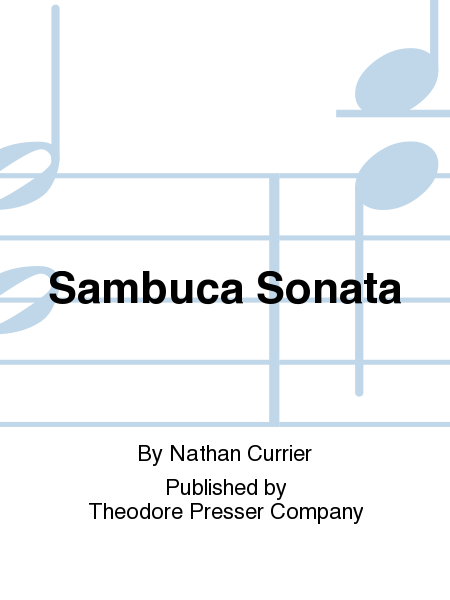Chamber Music Flute, Piano, Viola
SKU: PR.11440719S
Composed by Nathan Currier. Set of Score and Parts. With Standard notation. 44 pages. Duration 11 minutes, 30 seconds. Theodore Presser Company #114-40719S. Published by Theodore Presser Company (PR.11440719S).
UPC: 680160011087. 8.5 x 11 inches.
Sambuca, which most people know today as a licorice-flavored liqueur, was the name the Greeks gave to a kind of sharp, shrill-sounding harp, of Eastern, possibly Jewish origin. The Greeks then gave this same name to a wooden flute made from the elder bush, and in the middle ages it was also associated with the viol, at least to the extent that the Hurdy-gurdy, an instrument shaped like a viol and played by means of a rotating wheel, was sometimes called a Sambuca rotata. Thus, the word Sambuca is tied up with the ancestors - in each case, ancestors of ow birth, as it were - of the modern harp, flute, and viola. Somehow, the present-day association with alcohol seems very meet, in that a certain objectionable quality seems to have gone with the name - in 1545 one George Ascham wrote, This I am sure... all maner of pypes, barbitons, sambukes... be condemned of Aristotle. The word Sambucistria - for a female Sambuca player - was used by Plutarch and others to evoke a feeling of foreign-inspired decadence [Grove's Dictionary of Musical Instruments, 1984]. Currier's work is truly a Sambuca sonata. Written for the three Sambuca instruments, Currier has first of all seemingly endeavoured to make the harp part particularly Sambuca-like (i.e., sharp and shrill) with its many nail and xylophonic effects, but more importantly, has used musical material that corresponds to the low-brow, somewhat Dionysian, indeed, today even Bacchanalian implication of the name - thus, rock music seems to inspire a great deal Currier's work [the Samba, an appropriately Bacchanalian Brazilian Carnival dance, in duple meter with syncopations, while apparently having no etymological connection to Sambuca, might seem to be musically involved, too]. The Sambuca which lies behind this rather drunken piece is probably the only musical instrument which became a model for an instrument of war; one Craxton wrote in 1489 that Sambuce is an engyn whiche is made in manere of a harpe able to perce a walle. But whether talking of the modern liqueur or the ancient instrument condemned of Aristotle and mentioned four times in the Book of Daniel, it is a shame that Debussy - inspired by the Dionysian side of classical culture (as in Prelude a l'apres-midi d'un faune) - seems to have remained ignorant Sambuca, a word which to some extent must lie behind all works for this wonderful instrumentation which he invented, and which I might seem to have striven unconsciously, equally ignorant, to make the sole basis of Currier's work - until, having completed this piece, written for harpist Marie-Pierre Langlamet, and rummaging around for a title, I chanced upon it in an old dictionary.
Publisher : Theodore Presser Co.$34.99 - See more - Buy online
 (AMERICAN COMPANY)
(AMERICAN COMPANY) 

